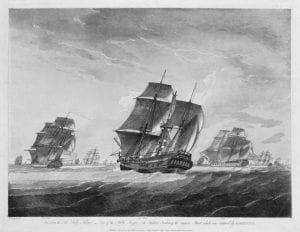
Photo: Robert Dodd / Wikimedia Commons / Public Domain
The Lady Juliana was a convict transport, the first to bring only female convicts to Australia, the first to sail after the first fleet and the first to be under private contract.
For various reasons, the departure of the Lady Juliana from England was long delayed. She lay in the Thames River for six months before sailing from Plymouth on 29 July 1789. Several accounts of her voyage have been written including a colourful account by one of the sailors on board, John NICOL (Flannery, 1997) and an analysis of the women on board titled The Floating Brothel – https://www.librarything.com/work/37457
In July 1789, 237 (?) women convicts left England for Botany Bay in Australia on board a ship called The Lady Juliana, destined to provide sexual services and a breeding bank for the men already there. This is the enthralling story of the women and their voyage. Based on painstaking research into contemporary sources such as letters, trial records and the first-hand account of the voyage written by the ship’s steward, John Nicol, this is a riveting work of recovered history. The Floating Brothel brilliantly conjures up the sights, sounds and particularly the smells of life on board ship at the time and is populated by a cast of larger-than-life characters you will never forget.
The Lady Juliana was a ship of 401 tons. She transported 222 female convicts to Port Jackson, arriving on 3 June 1790, 309 days after she left Plymouth, an unusually long voyage.
She called at Teneriffe and St. Jago, and was a hundred and twenty days out when she arrived at Rio de Janeiro, where she remained for forty-five days. From Rio she ran out to the Cape in fifty days, arriving at Table Bay on March 1, 1790. H.M.S. Guardian, which had left England six weeks after the Lady Juliana, arrived at the Cape more than three months before her. The Lady Juliana remained nineteen days at the Cape, and took seventy-five days for the passage from the Cape to Port Jackson. (Bateson, 1974, p.121)
The naval agent appointed to the Lady Juliana was Lieutenant Thomas EDGAR (nicknamed Little Bassey).
Nicol describes him as a “kind, humane man”, very good to the women convicts. “He had it in his power,” Nicol recalls, “to throw overboard all their clothes when he gave them the convict dress, but he gave them to me to stow in the after hold, saying they would be of use to the poor creatures when they arrived at Port Jackson.” (Bateson, 1974, p.120)
The surgeon was Richard ALLEY, by all accounts a competent medical officer, though unable to stop the fraternising between the sailors and convict women aboard the ship. Many of the sailors formed “relationships” with the convict women and some of the women sold their favours. The women also found ways to obtain alcohol and were often rowdy and drunk during the voyage.
Not all of the female convicts were involved in this behaviour. Some were put to work (and paid) by Captain Aitken making shirts out of linen he had brought on board. He made a tidy profit when he sold the shirts at Port Jackson. The female convicts were embarked from Newgate and county gaols, the majority being from London.
John NICOL recorded many stories about the journey of the Lady Juliana from England to Port Jackson which has allowed historians to put together a detailed picture of the journey.
At the Cape disaster almost overtook the Lady Juliana. The carpenter carelessly allowed the pitch-pot to boil over on deck, and as flames and smoke arose, the frightened women ran screaming about the deck, creating a great deal of confusion. Nicol says he was able to keep the fire under control until the seamen extinguished it with water, and the ship was saved from burning. She had another narrow escape when standing into Port Jackson in a strong southerly. She got close into North Head, and only the set of the tide saved her from going ashore. As it was, she was unable to make her way up harbour, and eventually had to be towed into Sydney Cove on June 6, three days after she had entered the heads. (Bateson, 1974, p.123)
Only five women died during the voyage – rations were properly issued, the ship was kept clean and fumigated and the women were given free access to the deck and received fresh provisions at their extended ports of call. Several of the women gave birth during the passage and many were pregnant upon arrival at Sydney Cove.
http://freepages.family.rootsweb. ancestry.com/~tcowley/Ships.htm#Lady%20Juliana